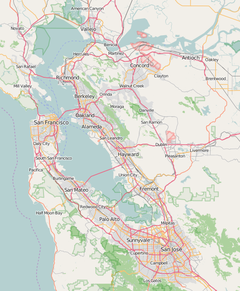| Kong Chow Temple | |
|---|---|
岡州古廟 | |
 | |
| Location | |
| Location | Corner of Stockton and Clay |
| Municipality | San Francisco |
| State | California |
| Sector | Chinatown |
| Geographic coordinates | 37°47′38″N 122°24′29″W / 37.793824°N 122.408071°W |
Kong Chow Temple ( traditional Chinese: 岡州古廟; simplified Chinese: 冈州古庙; pinyin: Gāngzhōu Gǔmiào; Jyutping: gong1 zau1 gu2 miu6) is a temple dedicated to Guan Di, located in the Chinatown neighborhood of San Francisco, California, in the United States. [1]
History
The temple was founded, in 1849, by members of the Cantonese population of San Francisco. In 1854, the temple was renamed Kong Chow Clan Association, to stress the social activities planned by the temple. The Association provided social welfare and religious needs for the community. Like many buildings in the area, it was destroyed in the 1906 San Francisco earthquake, and the community worked together to rebuild it [1] at its original location, 520 Pine, near St. Mary's Square. [2]
The Los Angeles branch of the Kong Chow Family Association and Temple was designed by architect Gilbert Leong [3] and opened in 1960. [4]
Bess Truman's visit
Bess Truman visited the temple in 1948, where she prayed for positive results for her husband, Harry S. Truman's presidential run. While there, she also asked for a prediction about the results, due to the public's prediction that he would lose. While there, she held a container of Kau cim sticks, and shook them until one of the sticks fell to the ground. This stick was then exchanged for a piece of paper, which told a story, offering insight to her question. The prediction was favorable, and Truman would go on to win the presidential election. The prediction slip that was given to her is displayed in the temple. [1]
Protests
In 1968 and 1969, while in her nineties, Charlotte Ah Tye Chang led protests against plans to demolish the old Kong Chow Temple. [5] [6] [7] [8] [9] Her niece, artist Nanying Stella Wong, joined her efforts. [10] Chang did not live to see the old temple demolished, or the new Kong Chow Temple erected at another location in 1977. [11]
Today

In 1977, the temple moved to its current building on Stockton Street in Chinatown, [1] [12] known as the Kong Chow Building. The association works closely with the elderly population, offers scholarships and other charitable projects for the neighborhood. They also organize prayer sessions, and participates in the Qing Ming Festival. Inside of the temple is a statue of Guan Di, which is worshipped in the main altar. [1]
References
- ^ a b c d e "Kong Chow Temple, 冈州古庙 San Francisco, USA". Chinatownology. 2011. Retrieved 25 December 2011.
- ^ "Mapping Chinatown History". Curbed San Francisco. 28 July 2017. Retrieved 7 June 2018.
- ^ "Gilbert Lester Leong; Architect, Founder of East West Bank". Los Angeles Times. 28 August 1996. Retrieved 2 January 2020.
- ^ Leong, Gilbert. "History of the Los Angeles Kong Chow Benevolent Association and the Kwan Gung Temple". Kong Chow Los Angeles. Retrieved 16 June 2021.
- ^ "Quirks in the News". Desert Sun. April 2, 1969. p. 27. Retrieved November 1, 2019 – via California Digital Newspaper Collection.
- ^ "Can the Little Temple be Saved?". The San Francisco Examiner. February 23, 1969. p. 236. Retrieved November 2, 2019 – via Newspapers.com.
- ^ "She Hopes to Save Temple". Oakland Tribune. April 2, 1969. p. 15. Retrieved November 2, 2019 – via Newspapers.com.
- ^ Ruggles, D. Fairchild (2011-11-19). On Location: Heritage Cities and Sites. Springer Science & Business Media. pp. 46–47. ISBN 9781461411086.
- ^ "Protester, 97, Pickets Temple". The San Francisco Examiner. April 1, 1969. p. 15. Retrieved November 2, 2019 – via Newspapers.com.
- ^ "Family Effort to Save a Temple". The San Francisco Examiner. February 18, 1969. p. 28. Retrieved November 2, 2019 – via Newspapers.com.
- ^ Choy, Philip (2012-08-14). San Francisco Chinatown: A Guide to Its History and Architecture. City Lights Publishers. p. 195. ISBN 9780872865402.
- ^ Fodor's (6 January 2009). Fodor's Northern California 2009: With Napa, Sonoma, Yosemite, San Francisco & Lake Tahoe. Random House Digital, Inc. p. 33. ISBN 978-1-4000-0805-6.
- Taoist temples in the United States
- Religious buildings and structures in San Francisco
- Chinatown, San Francisco
- Harry S. Truman
- Divination
- Religious organizations established in 1849
- 1849 establishments in California
- Guandi temples
- Buildings and structures destroyed by the 1906 San Francisco earthquake
- Temples in California

